Changes in children’s skin
This post was written by Dr. Pleimes, a specialist in pediatrics, dermatology and allergology
Click here to read further information about Dr. Pleimes.
Skin rashes are quite common in children. They can have various causes, from harmless reactions to environmental influences to infectious childhood diseases. Skin rashes can take many different forms.
- The changes can occur only on certain parts of the body (localized, e.g. only on the cheeks) or affect the entire body skin (generalized).
- They can have a smooth surface or be scaly.
- Some of them can cause itching, while others do not itch.
In most cases, changes only exist for a few days to weeks, but rarely skin problems can lead to permanent impairment.
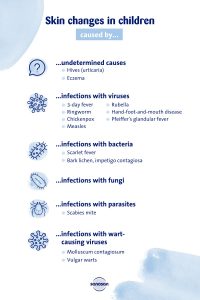
Causes of skin changes
Only for some of the rashes can a cause be identified with certainty (e.g. typical course and rash in chickenpox), for others at least a specific factor can be identified that triggers the rash (e.g. an infection that then triggers hives). In some rashes, however, neither one nor the other will be found (e.g. a non-specific viral exanthema).
In many cases (certainly very common in eczema and hives), families suspect allergies or food as the cause. Contrary to this perception, however, genuine allergies are very rarely the cause of pure skin problems.
An itchy rash in children can often be eczema or hives. Some rashes caused directly by an infection can also be itchy (e.g. chickenpox or scabies).
Skin changes due to undetermined causes
Hives (urticaria)
Hives are typically characterized by patches of varying size, ranging from a few mm to many cm, or usually slightly raised/swollen redness on the skin, which only remain in one place for a few hours and always disappear again after less than 24 hours. However, because new spots may appear again and again, it may seem as if the rash persists all the time. The rash of hives NEVER flakes.
Hives can occur at any age. In childhood, the trigger is usually an infection. As a result, you can imagine that our immune system continues to work at a higher level of activity for a while and therefore releases its messenger substances more easily. The affected area is then supplied with more blood and a nettle or wheal appears locally, which disappears again after a few hours. Allergies to food or medication can also trigger urticaria. However, this can usually be recognized by the fact that the rash appears in the next few minutes after ingesting the medication or food. Rarely, mechanical (friction) or physical stimuli (e.g. cold, heat) can also trigger such reactions. As the rash is itchy and can be improved by a so-called antihistamine, a visit to the pediatrician/family doctor is advisable. However, further clarification is only necessary if an allergy is very likely or if wheals come and go for more than 6 weeks. This is known as chronic urticaria. Fortunately, this is also not dangerous and is much rarer than acute urticaria, which disappears after a few days or weeks.
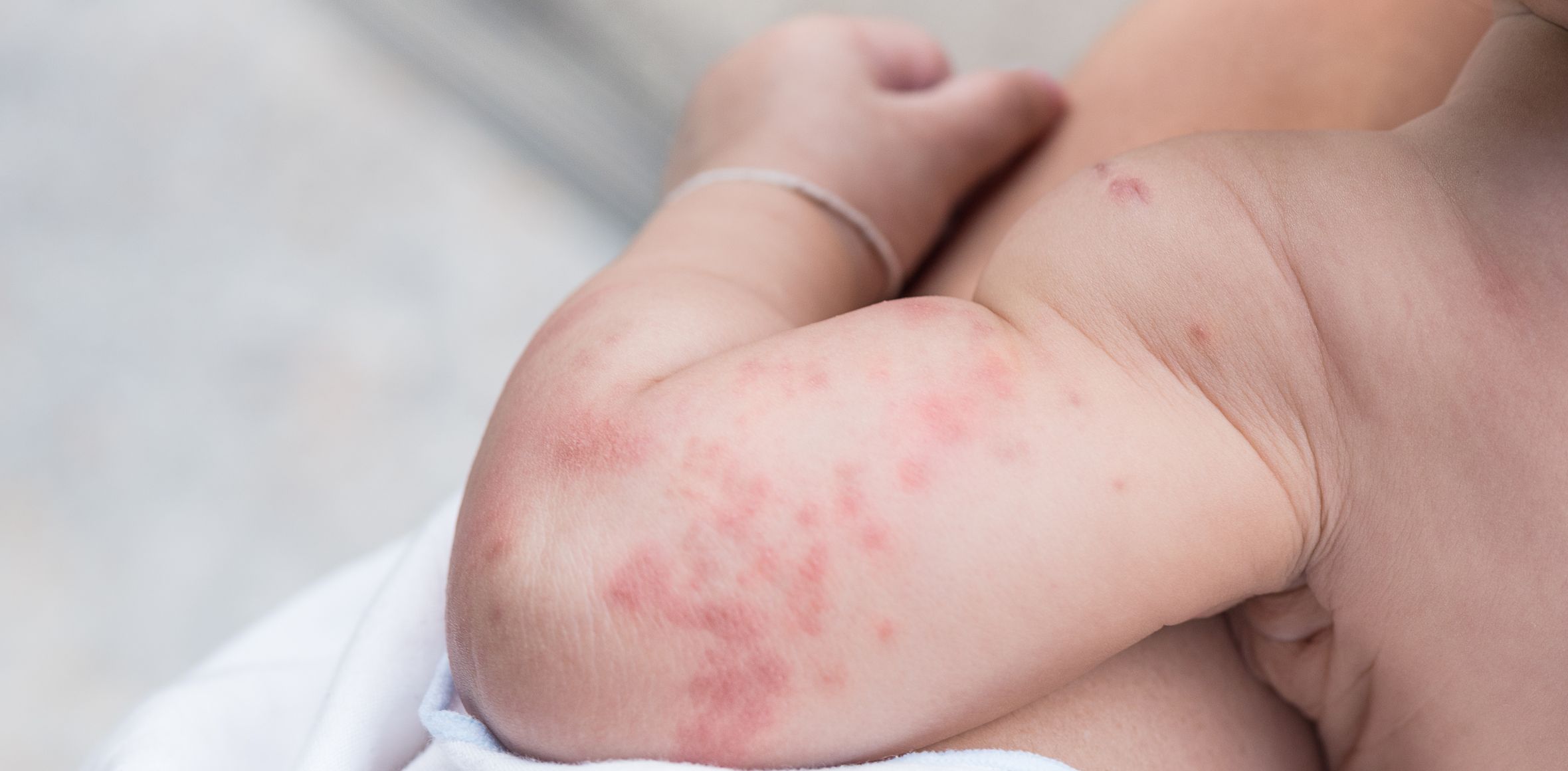
Eczema
Eczema is a combination of skin changes characterized by redness, varying degrees of thickening and scaling / or, in very acute cases, oozing.
The background is usually an increased sensitivity of the epidermis (weakened skin barrier) as part of atopic dermatitis (also known as atopic eczema or neurodermatitis). With eczema, your child’s skin itches and then becomes red, irritated and dry. Unfortunately, this process then exacerbates the initial problem of increased skin sensitivity and often leads to a vicious circle. To prevent this as far as possible, regular basic therapy is recommended for skin prone to eczema. This skin care includes regular careful cleansing of the skin (e.g. with a short bath in lukewarm water) and regular application of a suitable skin care cream (usually a moisturizer with quite oily products). This should always be applied after bathing or showering.
If these measures do not heal the skin areas, the pediatrician may need to add a prescription anti-inflammatory cream, e.g. a cortisone preparation, to the therapy.
Contact dermatitis / contact eczema can occur when children react with inflammation to a substance that comes into contact with the skin. These can be fragrances or certain cream ingredients, for example. There may then be a contact allergy. This does not usually occur on first contact, but with ingredients that have already come into frequent contact with our skin. Typically, changes only occur at the points of direct contact. Cosmetics or therapy creams should therefore contain as few of these possible irritants (including fragrances, soaps, dyes, wool waxes) as possible. There are also directly irritating substances (e.g. jellyfish toxins, certain plant components) that can trigger non-allergic contact dermatitis. Contact dermatitis causes an itchy or possibly burning rash at the points of contact. Treatment includes itch-relieving moisturizers and anti-inflammatory cortisone creams.
Skin changes due to infections with viruses
Many childhood rashes are caused by infections.
Viral infections such as 3-day fever, ringworm, chickenpox, measles, rubella or hand-foot-and-mouth disease often trigger rashes.
Chickenpox, measles or rubella can be largely prevented by vaccination. They are therefore observed less frequently nowadays.
3-day fever
Initially, there is usually a high fever for several days, which is difficult to bring down, but the general condition is still quite good. As soon as the fever subsides, a fine-spotted, often only light red, discrete rash may appear on the chest and abdomen. The rash can spread to your child’s upper arms and neck and usually disappears again within a few hours to a day. The rash does not itch or hurt. The cause is an infection with the human herpes virus 6 or 7 (HHV6/7).
Ringworm
They are initially characterized by non-specific, usually mild signs of infection, such as a slight fever. The rash begins with severe reddening of the cheeks. This subsides after a few days and a blotchy rash may appear. This becomes more garland-like, especially on the arms and legs. At the time of the rash, the infectious period of ringworm is already over. The ringworm rash can occur repeatedly over several months in some children. The disease is caused by an infection with parvovirus B19.
Chickenpox
Caused by the varicella zoster virus. The chickenpox rash often starts on the head and spreads to the chest and back and the rest of your child’s body. Typically, the hairy head is also affected. First watery blisters appear, then small yellowish pustules and then crusts. Several of these lesions coexist at the same time. Your child will feel ill, often with only a moderate fever. Chickenpox usually disappears by itself within one to two weeks. It is contagious until all the blisters have crusted over. If itching occurs, local anti-itch preparations or an antihistamine can have a soothing effect.
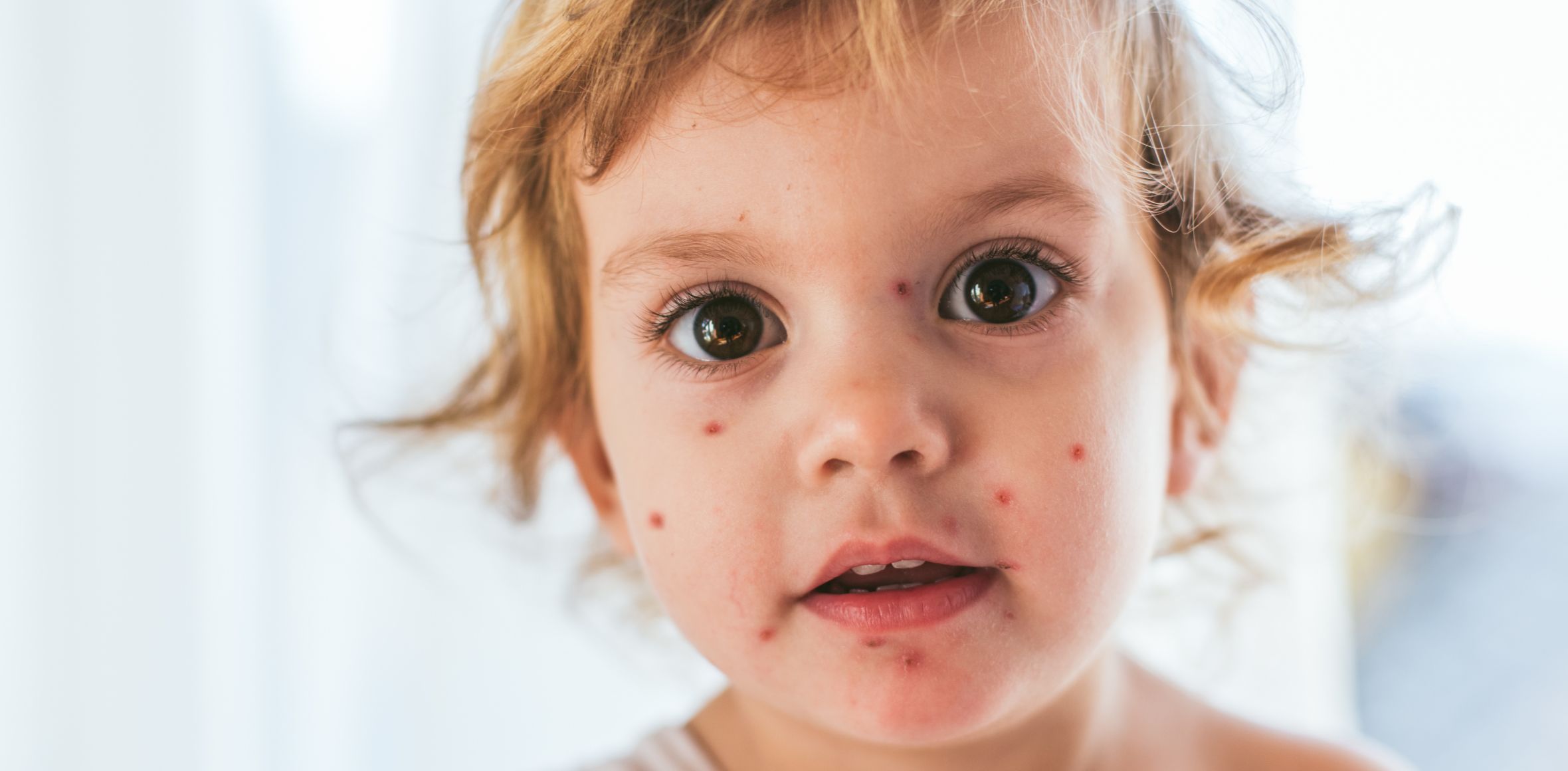
Measles
About 10 days after infection, the first symptoms are fever, cough, runny nose and conjunctivitis. An early sign is whitish spots on the inside of the cheeks: so-called Koplik’s spots. The typical rash with renewed fever only develops after a short period of fever relief. Red, possibly slightly raised spots appear behind the ears and on the face and then spread down the body. Individual spots can merge to form larger red patches. This rash disappears again after two weeks. Measles is caused by the Moribilli virus.
The problem with measles is that, in addition to an acute inflammation of the brain, it can also lead to a chronic inflammation of the nervous system that occurs years after the infection, which cannot be cured even with modern medical measures. Fortunately, the recommended vaccinations protect your child from these life-threatening problems.
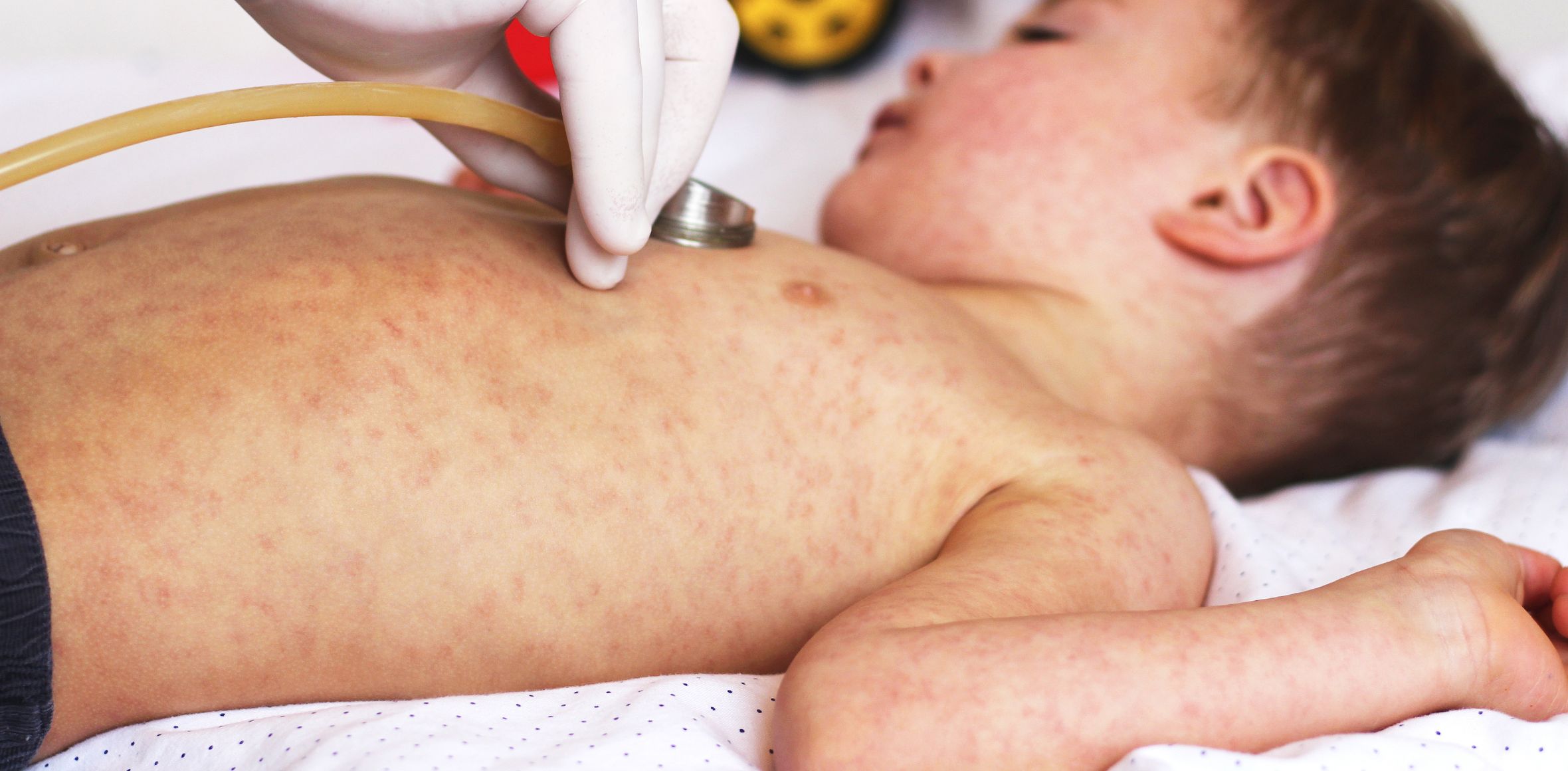
Rubella
Rubella is caused by the rubella virus. Only around half of all affected children develop a rash. This is characterized by bright red, very small spots on the skin, especially on the neck and face. The rash is only present for a short time and usually lasts 2-3 days. Younger children are usually not very ill and hardly have a fever. Occasionally, however, complications such as encephalitis can occur. The infection is very much feared during pregnancy, where the unborn child can be severely damaged. Rubella can also be easily prevented by vaccination.
It is caused by a virus from the entero- / Coxsacki virus group. Many of the enteroviruses can cause rashes and changes similar to hand-foot-and-mouth disease. This causes red blisters and defects in the skin around the mouth, on the hands and feet, but also in the diaper area of many children. The oral mucosa is also affected. The affected areas can be painful. A fever/painkiller may provide relief until the symptoms disappear on their own within 1-2 weeks.
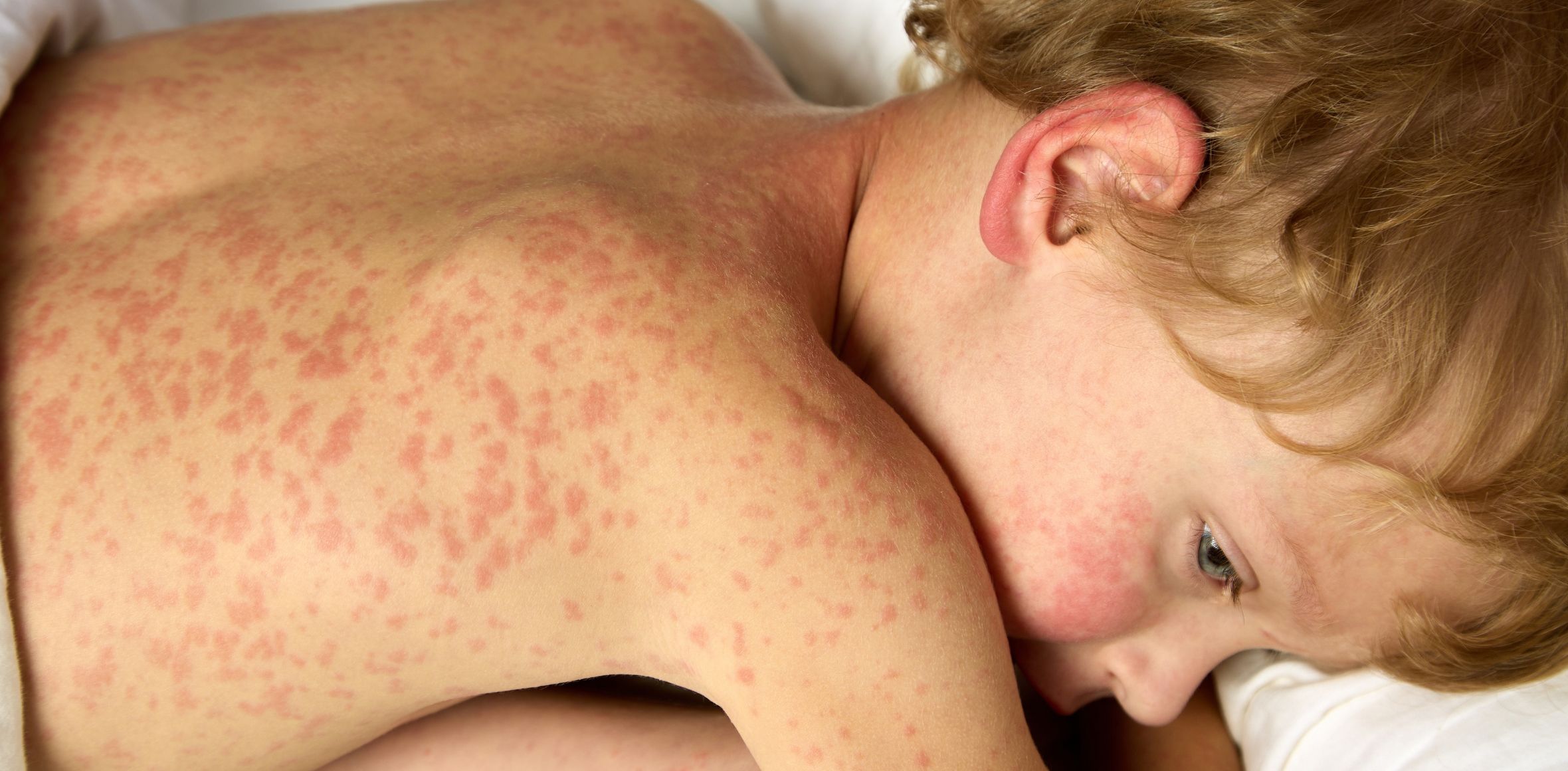
Hand-foot-and-mouth disease
It is caused by a virus from the Entero- / Coxsacki virus group. Many of the enteroviruses can cause rashes and changes similar to hand-foot-and-mouth disease. This causes red blisters and defects in the skin around the mouth, on the hands and feet, but also in the diaper area of many children. The oral mucosa is also affected. The affected areas can be painful. A fever/painkiller may provide relief until the symptoms disappear on their own within 1-2 weeks.
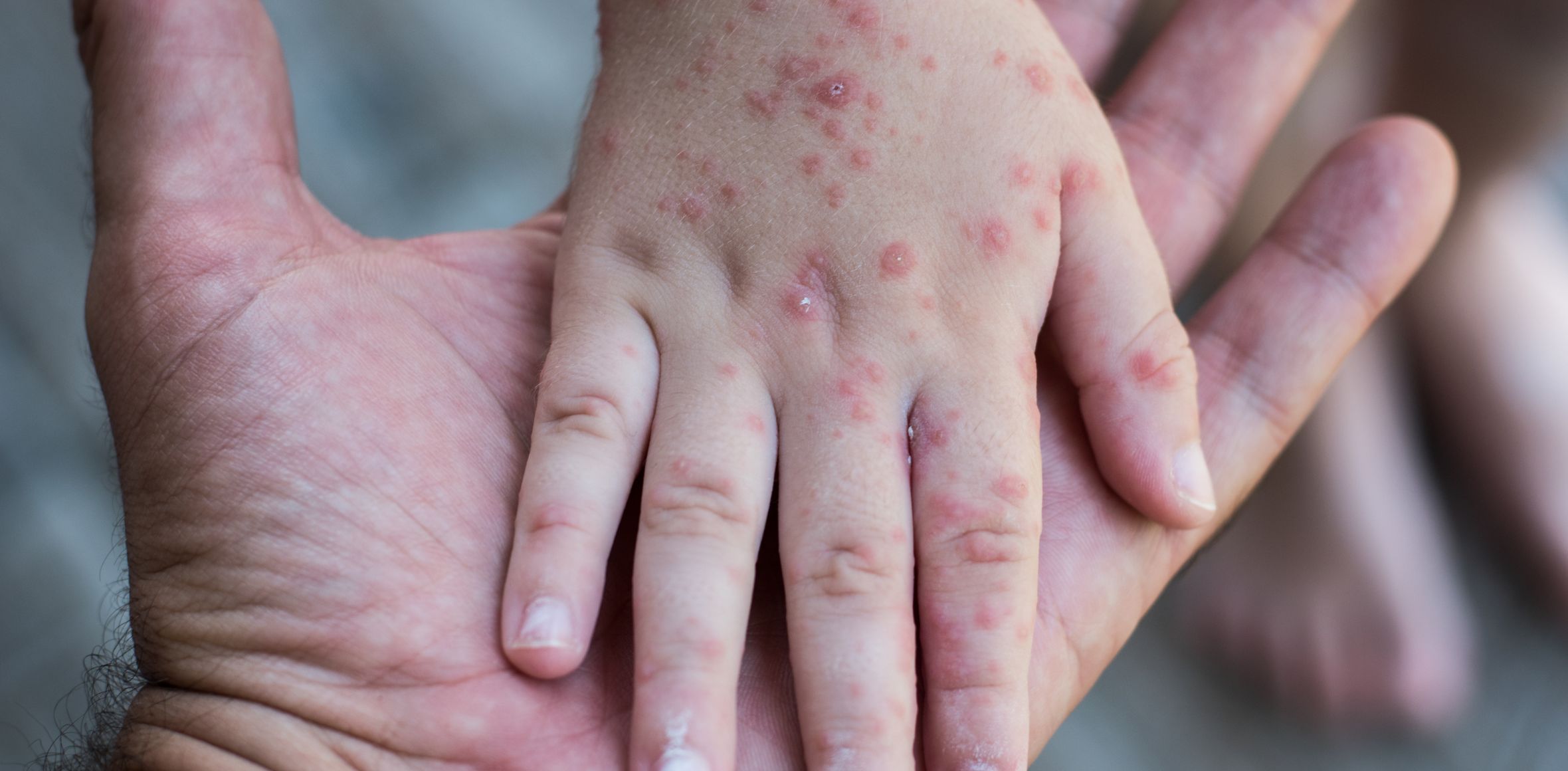
Pfeiffer’s glandular fever
Pfeiffer’s glandular fever or infectious mononucleosis is caused by an infection with the Ebstein-Baar virus (EBV). The children affected are usually of school age. In addition to general symptoms of the disease, there is often unilateral tonsillitis and severely swollen lymph nodes in the neck. The liver and spleen are also often enlarged. If the tonsillitis is mistaken for a bacterial infection and an antibiotic such as amoxicillin is given (no effect with EBV), the infection is almost always accompanied by an often pronounced measles-like rash.
Skin changes due to infections with bacteria
Infections with bacteria can also trigger rashes.
Scarlet fever
Is caused by bacteria, group A streptococci, some of which can also cause the typical rash. The triggering infection is usually a sore throat, but a scarlet fever rash can also occur with a wound infection or soft tissue inflammation of the skin. At the beginning there is usually a fever, a restricted general condition and a sore throat and headache. Typical symptoms are red cheeks, pale skin around the mouth and a very red tongue (raspberry tongue). The rash with fine red spots spreads from the neck to the chest and body, and finally to the arms and legs. This rash is typically rough (sandpaper-like) and slightly scaly. The rash may be followed by more severe desquamation, particularly on the hands and groin area. The treatment of scarlet fever includes general antipyretic measures and antibiotics.
Bark lichen, impetigo contagiosa
It occurs most frequently in children aged 2 to 5 years, but can occur at any age. Bark lichen is a direct infection of the skin and the children usually have no other abnormalities apart from possibly locally swollen lymph nodes. Red, raised patches appear, some of which develop blisters and then yellowish to light brown crusts. Sometimes there are only weeping, bright red raised patches, which increase in number over time. Most frequently, bark lichen occurs in the mouth and nose area. However, the bacteria can be spread from there to other irritated areas of skin. Smaller areas can be treated locally with antibacterial agents. In more severe cases, an antibiotic is administered as a juice or tablet. The bacteria are usually the trigger: Streptococcus or Staphylococcus.
Skin changes due to infections with fungi
Other germs, such as fungi, can also cause skin infections and thus spreading rashes.
Fungi are usually transmitted from person to person (also via contact surfaces such as swimming pool floors, gym mats, etc.) or from animals to humans. A fungus usually scales. However, severely inflamed areas can also form pus pustules and be weeping. An area usually begins with a small reddening, thickening and scaling, which then develops with a slightly thicker edge area into an oval area that is increasingly red and scaly on the outside. Further areas may then appear as the disease progresses. Small areas of skin can be treated well with an antifungal cream.
Care must be taken if fingernails, toenails, scalp hair or eyebrows are affected. In this case, topical creams are often no longer sufficient and you should take your child to a doctor to check whether treatment with a juice or tablet is necessary. It is also helpful to find the source of the infection, e.g. a pet, so that this can also be treated (by the vet).
Skin changes due to infections with parasites
Parasites can also infest the skin. The scabies mite (scabies mite) is of particular importance here. It is only transmitted from person to person and almost exclusively through close skin contact. The first reddened areas (small red papules or nodules) only appear a few weeks after skin infection. In younger children, the palms of the hands and soles of the feet are often affected, as well as the groin and armpits. This can also be accompanied by eczema, similar to atopic dermatitis. For treatment to work well, it is important to carry out a series of measures in a well-coordinated manner. Not only the affected child, but also ALL close contacts must be treated at the same time. The correct application of all preparations should be well understood before treatment. Both creams and tablets for children >15 kg body weight are available for treatment. The surrounding area, sleeping area and contact objects must be cleaned of mites before and after treatment to prevent re-infection. As itching and eczema often persist for several weeks even after successful treatment, these problems should also be treated.
Skin changes due to infections with wart-causing viruses
Molluscum contagiosum
Molluscum contagiosum warts are caused by a skin infection with the molluscum contagiosum virus. This skin infection is very common, especially in young children. Single to many small skin-colored papules (usually only 1-3 mm in diameter) develop. The slightly larger ones may be dented in the middle. Molluscum contagiosum can also become inflamed. In the area surrounding molluscum contagiosum, some children also develop extensive scaly redness: Eczema. Children with a history of neurodermatitis are particularly affected due to their weaker skin barrier and can often develop a large number of molluscum contagiosum. In principle, the disease is not dangerous and in the course of months to a maximum of one to two years, almost all children heal without any further measures. However, the spots can be very annoying due to their visibility and the accompanying eczema and itching. Individual molluscum contagiosum can be treated with a potassium hydroxide solution. In slightly older children, the molluscum contagiosum can also be removed by a doctor.
Vulgar warts
Vulgar warts in children are also a viral infection of the skin. They are caused by different types of the human papillomavirus (HPV). The infection causes rough, highly keratinized papules or circular rough thickenings to form on the foot. Occasionally, small black dots can be observed in the wart, which are tiny harmless vascular occlusions. Even though warts often heal on their own in children before puberty, some children are persistently affected for years. As the warts multiply, and particularly in areas on the soles of the feet, which can be painful, the warts can severely affect children.
In children, the most important therapeutic measure is to loosen the horny layer with appropriate tinctures or plasters until the epidermis / horny layer containing the wart viruses has been largely removed. Warts occur most frequently on the hands and fingers. However, they can occur anywhere on the skin and even on mucous membrane areas.
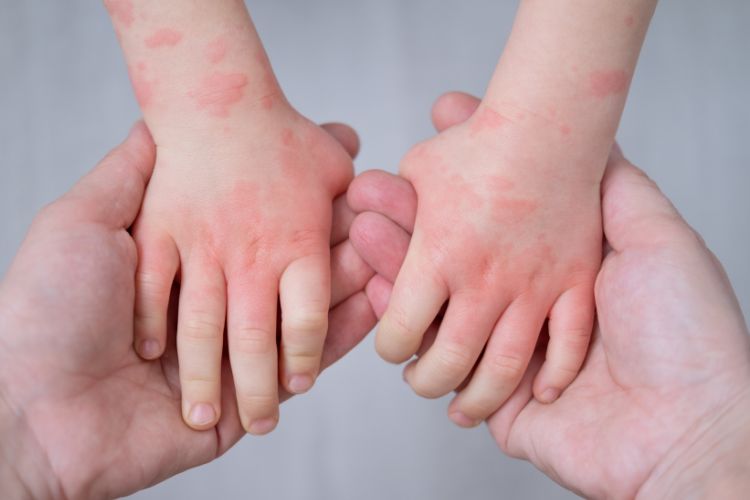

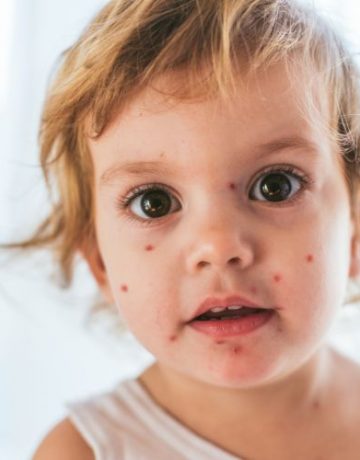
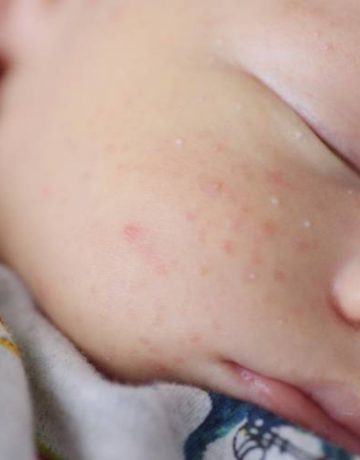
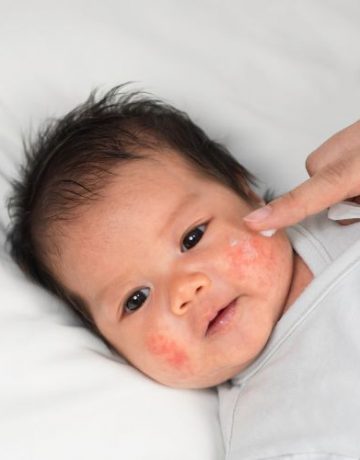

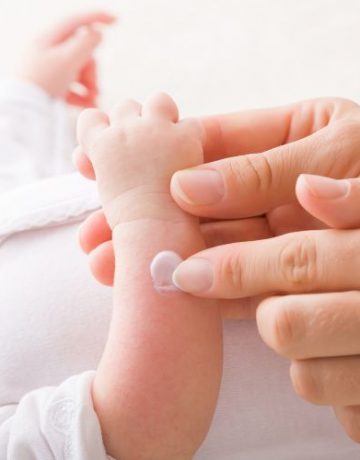

Comments (0)